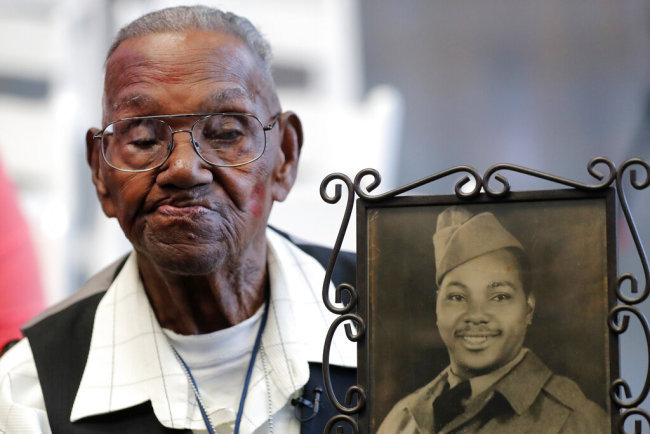Oldest US veteran of WWII, Lawrence N. Brooks, dies at 112
Lawrence N. Brooks, the oldest World War II veteran in the U.S. — and believed to be the oldest man in the country — died on Wednesday at the age of 112.

World War II veteran Lawrence Brooks holds a photo of him taken in 1943, as he celebrates his 110th birthday at the National World War II Museum in New Orleans, on Sept. 12, 2019. [Photo: AP]
His death was announced by the National WWII Museum and confirmed by his daughter.
Most African Americans serving in the segregated U.S. armed forces at the beginning of World War II were assigned to noncombat units and relegated to service duties, such as supply, maintenance and transportation, said Col. Pete Crean, vice president of education and access at the museum in New Orleans.
“The reason for that was outright racism — there’s no other way to characterize it,” Crean said.
But Brooks, born on Sept. 12, 1909, was known for his good-natured sense of humor, positivity and kindness. When asked for his secret to a long life, he often said, “serving God and being nice to people.”
“I don’t have no hard feelings toward nobody," he said during a 2014 oral history interview with the museum. "I just want everything to be lovely, to come out right. I want people to have fun and enjoy themselves — be happy and not sad.”
On sunny days, Brooks was known for sitting on the front porch of the double shotgun house he shared with daughter Vanessa Brooks in the Central City neighborhood of New Orleans. Neighbors would call out to the local celebrity, wave and bring him soda and snacks.
Brooks was passionate about the New Orleans Saints football team and never missed a game, his daughter said. His church, St. Luke’s Episcopal, was also close to his heart and he never missed a Sunday service until the coronavirus pandemic hit.
Originally from Norwood, Louisiana, near Baton Rouge, Brooks' family moved to the Mississippi Delta when he was an infant. He was one of 15 children, and lived too far from the nearest school, so his parents taught him what they could at home.
Brooks was working at a sawmill when he was drafted into the U.S. Army in 1940. After Japan's attack on Pearl Harbor, he was assigned to the mostly Black 91st Engineer General Service Regiment stationed in Australia.
Later in the war, troop losses virtually forced the military to begin placing more African American troops into combat positions. In 1941, fewer than 4,000 African Americans were serving in the military. By 1945, that number increased to more than 1.2 million.
The 91st, where Brooks served, was an Army unit that built bridges, roads and airstrips for planes. Brooks was assigned as a caretaker to three white officers. His job was to cook, drive and take care of their clothes.
President Joe Biden on Wednesday posted a video on Twitter of him calling Brooks to wish him a happy Veterans Day last year.
“He was truly the best of America,” Biden tweeted.
In the Veterans Day video, Biden thanked Brooks' daughter Vanessa for taking such good care of him.
“What people don't realize — you look at your dad and think of all of the African American men who fought — and some who died — in World War II and never got credit," he said.
Brooks did not often speak publicly about the discrimination he and other Black soldiers faced in the war, or the discrimination his family faced in the Jim Crow Deep South, his daughter said.
Crean, who got to know Brooks and his family through his work at the museum, said Brooks did talk about noticing how much better he was treated as a Black man in Australia compared with the U.S. But Brooks told Crean thinking about it would make him angry, so he tried not to. During his oral history interview, Brooks said the officers he cared for treated him well and he considered himself fortunate not to have to fight in combat.